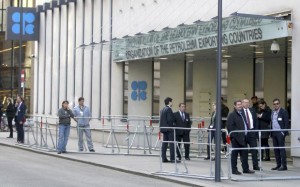
Persons stand in front of the headquarters of the Organization of the Petroleum Exporting Countries (OPEC) in Vienna, Austria, Saturday, Dec. 10, 2016. OPEC member states are meeting with Russia and other non-OPEC countries in Vienna for talks about a reduction in oil production. Secretary General Mohammed Barkindo said the discussions began Saturday in a “positive atmosphere” at the headquarters of the oil producers’ cartel. (Photo by RONALD ZAK/AP)
VIENNA — OPEC has persuaded 11 non-member oil producers to cut production in an attempt to raise the low prices that have squeezed government finances in resource-dependent countries.
Qatari Energy Minister Mohammed bin Saleh al-Sada, OPEC’s president, said Saturday that non-members agreed to cut 558,000 barrels per day, less than the 600,000 barrels a day that OPEC had hoped for.
Those non-member cuts come on top of an OPEC decision Nov. 30 to reduce member output by 1.2 million barrels a day.
Saudi oil minister Khalid Al-Falih called Saturday’s deal “historic” and said it would stabilize the market through next year and encourage industry investment. The announcement came after OPEC member states met with Russia and other non-OPEC countries in Vienna for talks on production cuts.
The 11 non-OPEC countries taking part in the agreement are: Azerbaijan, Bahrain, Brunei, Equatorial Guinea, Kazakhstan, Malaysia, Mexico, Oman, Russia, Sudan and South Sudan.
Secretary General Mohammed Barkindo said much of the production cuts were expected to come from Russia, which was co-chairing the meeting.
Russian energy minister Alexander Novak called the meeting “a unique window of opportunity for oil producers to help the market find equilibrium. And missing this chance would just be wrong.”
Major oil producers such as Russia and Saudi Arabia have seen an oil glut send prices lower and cramp their state budgets.
It remains to be seen whether the cutbacks will do much to raise prices, given OPEC members’ track record of exceeding agreed-upon production quotas.
Oil fell from over $90 per barrel in early 2014 to as low as $40 earlier this year, briefly sending the average price of regular gasoline at the pump to under $2 for motorists in the United States. Oil closed at $51.58 on Friday, up 6 percent since the OPEC production cut was announced.
Crude prices have risen since the OPEC agreement was announced. That’s despite doubts about how much impact any OPEC-led cutback will have due to weak demand from a sluggish global economy.